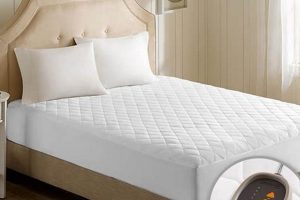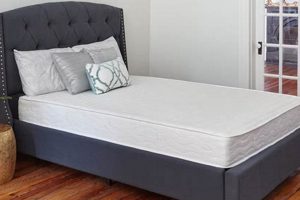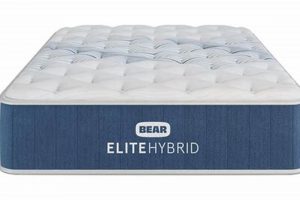A bed dimension exceeding a standard full, or double, mattress in length. This configuration provides additional legroom, typically catering to taller individuals who find conventional full-size mattresses too short. As an example, a standard full mattress measures 54 inches wide and 75 inches long, while the extended version maintains the width but increases the length to approximately 80 inches.
This extended length offers significant advantages for individuals who require more sleeping space. By preventing feet from hanging off the end of the bed, it promotes better spinal alignment and reduces discomfort. Historically, bedding dimensions were more standardized, but increasing awareness of individual needs has led to the development of specialized sizes to accommodate varying body types and sleep preferences. The existence of this product indicates a market that values personalized comfort and ergonomic support during rest.
The availability of this mattress dimension influences choices related to bedroom furniture, bedding, and overall sleep quality. Understanding the specific measurements and benefits helps consumers make informed decisions when selecting a mattress. The following sections will delve into specific considerations regarding purchasing, associated bedding, and suitability for different sleepers.
Tips for Selecting a Suitable Extended Length Full Mattress
The subsequent guidelines assist in making informed decisions regarding the selection and use of an extended-length full mattress. Careful consideration of these points can contribute to enhanced sleep quality and overall satisfaction.
Tip 1: Measure Bedroom Space Accurately: Prior to purchase, precisely measure the available floor space in the bedroom. Ensure sufficient room for the mattress, bed frame, and comfortable movement around the room. Consider placement of other furniture and accessibility to doors and windows.
Tip 2: Evaluate Individual Height and Sleep Style: Assess the height of the intended user and consider sleeping habits. Individuals taller than average, or those who tend to stretch out during sleep, will benefit most from the added length. Side sleepers may require less length than those who sleep on their back or stomach.
Tip 3: Research Frame Compatibility: Verify the compatibility of the mattress with the chosen bed frame. Standard full-size frames are not designed to accommodate the extended length. A frame specifically designed for this configuration will provide adequate support and prevent damage to the mattress.
Tip 4: Explore Bedding Options: Identify available bedding options specifically designed for this mattress dimension. Standard full-size sheets will not fit properly. Ensure availability of fitted sheets, flat sheets, and comforters in the appropriate size to ensure a secure and comfortable fit.
Tip 5: Consider Mattress Type and Firmness: Evaluate preferred mattress type (e.g., memory foam, innerspring, hybrid) and firmness level based on individual preferences and support needs. Different mattress types offer varying degrees of support, pressure relief, and temperature regulation.
Tip 6: Read Reviews and Compare Brands: Prior to making a purchase, research customer reviews and compare different brands offering this mattress dimension. Reviews can provide valuable insights into mattress durability, comfort, and overall customer satisfaction.
Tip 7: Inquire About Warranty and Return Policies: Before finalizing the purchase, carefully review the manufacturer’s warranty and return policies. A comprehensive warranty provides protection against defects in materials and workmanship. A generous return policy allows for testing the mattress at home and returning it if it does not meet expectations.
Selecting the appropriate mattress entails careful evaluation of space constraints, individual needs, and available product options. Adherence to these guidelines promotes a more informed decision-making process, leading to a more satisfactory sleep experience.
The subsequent section will address common misconceptions and provide a comparative analysis with alternative mattress sizes.
1. Dimensions
The defining characteristic of a full XL mattress lies in its dimensions. A standard full mattress measures 54 inches in width and 75 inches in length. The ‘XL’ designation signifies an extension in length, typically to 80 inches, while maintaining the 54-inch width. This dimensional alteration directly addresses the needs of individuals who find the length of a standard full mattress inadequate. For example, a person measuring 6 feet tall (72 inches) would likely find a standard full mattress uncomfortably short, leading to compromised sleep posture and potential discomfort. The additional 5 inches provided by the extended length can significantly improve sleep quality in such cases.
The practical significance of these dimensions extends beyond mere comfort. Insufficient mattress length can contribute to poor spinal alignment, as the individual’s feet may hang off the end of the bed, causing the body to compensate and potentially leading to back pain or other musculoskeletal issues. Moreover, inadequate space can disrupt sleep patterns, as the individual may unconsciously adjust their position throughout the night in an attempt to find a more comfortable posture. The extended length provides a more consistent and supportive sleep surface, minimizing these disruptions and promoting better rest. This understanding is crucial for consumers making informed purchasing decisions, as it highlights the direct correlation between mattress dimensions and sleep health.
In summary, the dimensions of a full XL mattress are not merely arbitrary measurements but rather deliberate design choices that directly impact comfort, support, and overall sleep quality, particularly for taller individuals. Neglecting the importance of mattress dimensions can lead to compromised sleep posture and potential health issues. Therefore, a thorough understanding of these measurements is essential for selecting a mattress that adequately meets individual needs and promotes a restful night’s sleep. The challenge lies in ensuring consumers have access to clear and accurate information regarding mattress dimensions and their implications, enabling them to make informed decisions.
2. Comfort
Comfort, as it pertains to a full XL mattress, is directly linked to the extended length dimensions. A standard full mattress, at 75 inches, may prove inadequate for taller individuals, leading to discomfort due to restricted legroom. The extended length of a full XL, typically 80 inches, alleviates this restriction, permitting a more natural and relaxed sleep posture. The cause-and-effect relationship is clear: insufficient mattress length causes postural contortions and discomfort, whereas adequate length fosters proper alignment and improved comfort. The importance of comfort as a component of this mattress size is paramount; it directly impacts sleep quality, reduces pressure points, and minimizes the likelihood of waking due to restlessness. For example, an individual who consistently experiences foot overhang on a standard full mattress may suffer from disrupted sleep patterns and increased leg cramps. Transitioning to a full XL eliminates this physical constraint, allowing for uninterrupted sleep and a greater sense of overall comfort. The practical significance of this understanding allows consumers to select a mattress that genuinely meets their physical requirements.
The correlation between comfort and the internal composition of the mattress is undeniable. A full XL constructed with high-density memory foam, for example, will offer a different comfort profile than one with traditional innerspring coils. The former conforms to the body’s contours, distributing weight evenly and reducing pressure points. The latter provides a more responsive and supportive surface, but may not offer the same level of pressure relief. Furthermore, the presence of additional comfort layers, such as quilted tops or gel-infused foam, can significantly enhance the overall sleeping experience. Practical applications include tailoring the mattress selection to specific needs. Individuals with chronic back pain may benefit from a memory foam full XL, while those who prefer a firmer sleeping surface might opt for an innerspring model. This highlights the interplay between the physical dimensions and the materials used in construction, both of which contribute to the overall comfort level.
In summary, the connection between comfort and the full XL mattress size is multifaceted. It is not solely determined by the extended length, but also by the internal construction and materials used. Insufficient length leads to physical discomfort and disrupted sleep, while the right combination of dimensions and materials promotes restful and restorative sleep. A challenge lies in navigating the array of mattress types and comfort levels available, requiring consumers to carefully consider their individual needs and preferences. This is crucial for translating the theoretical benefits into a tangible improvement in sleep quality and overall well-being, addressing a specific need in the broader market of bedding solutions.
3. Support
Adequate support is a critical attribute of any mattress, including the full XL size. The extended length of a full XL mattress necessitates sufficient support to prevent sagging and maintain proper spinal alignment across the entire sleeping surface. The cause-and-effect relationship is straightforward: inadequate support leads to spinal misalignment and potential back pain, while sufficient support promotes proper posture and minimizes pressure points. Support functions as a foundational element; without it, the benefits of the extended length are diminished. For example, an individual utilizing a full XL mattress with insufficient support may still experience discomfort, as their hips or shoulders could sink into the mattress, disrupting spinal alignment despite the extra legroom. The ability to select a mattress of correct dimensions and supportiveness has immense practical value in improving long-term physical health.
The degree of support is inherently linked to the mattress’s internal construction. Innerspring mattresses, for example, provide support through a network of coils, while memory foam mattresses rely on their density and contouring properties. Hybrid mattresses combine these technologies, aiming to provide both support and comfort. A practical application involves selecting a mattress type based on individual body weight and sleeping position. Heavier individuals may require a mattress with a higher coil count or a denser foam to ensure adequate support. Side sleepers often benefit from mattresses with targeted support zones that cradle the hips and shoulders, maintaining spinal alignment. The proper support selection can also mitigate the development of pain conditions.
In summary, the relationship between support and the full XL mattress size is essential for a comfortable and healthy sleep experience. The extended length requires commensurate support to prevent sagging and maintain spinal alignment. Insufficient support negates the benefits of the added length, potentially leading to discomfort and back pain. The challenge lies in identifying a mattress that provides the appropriate level of support for an individual’s body type and sleeping position. Addressing this challenge is crucial for translating the theoretical benefits of this specific dimension into a tangible improvement in sleep quality and overall well-being. Therefore, a comprehensive understanding of support mechanisms is critical for optimizing sleep.
4. Durability
The durability of a full XL mattress is intrinsically linked to its construction and materials. A mattress of this size, designed to accommodate potentially taller and heavier individuals, necessitates robust materials and construction techniques to withstand prolonged use without significant degradation. A mattress with inferior durability will exhibit sagging, loss of support, and compromised comfort over time. For instance, a full XL mattress using low-density foam may initially provide adequate comfort, but will likely compress and deform more rapidly compared to one utilizing high-density foam. The significance of durability as a component of this mattress size is paramount, as it directly impacts the lifespan of the product and the long-term value proposition for the consumer. Selecting a durable mattress ensures consistent performance and minimizes the need for premature replacement, thereby reducing both financial burden and environmental impact. The understanding of this connection has significant practical consequences; it empowers consumers to make informed purchasing decisions based on material quality and construction methods, prioritizing longevity and sustained performance over short-term cost savings.
The internal components of a full XL mattress, such as the coil system in an innerspring model or the foam layers in a memory foam or hybrid model, directly influence its overall durability. A full XL innerspring mattress with a low coil count and thin-gauge steel coils is inherently less durable than one with a high coil count and thicker-gauge coils. Similarly, a memory foam mattress with a low-density base layer will be more susceptible to compression and sagging compared to one with a high-density base. Practical application dictates careful evaluation of the materials used in construction, looking for indicators of quality such as coil count, steel gauge, foam density, and the presence of reinforced edges to prevent premature wear. Warranty terms also serve as an indicator of durability; manufacturers who offer longer warranties typically have greater confidence in the longevity of their products. These warranty conditions should be assessed and fully understood prior to any purchasing decisions.
In summary, the connection between durability and the full XL mattress size is critical for ensuring long-term comfort, support, and value. A durable mattress maintains its structural integrity and performance characteristics over time, minimizing the need for replacement and providing a consistent sleeping surface. The challenge lies in accurately assessing the durability of a mattress based on limited information and often opaque manufacturing processes. Addressing this challenge requires a proactive approach involving thorough research, careful evaluation of material specifications, and a critical assessment of manufacturer warranties. By prioritizing durability, consumers can ensure they are making a sound investment that will provide years of comfortable and restful sleep.
5. Frame Compatibility
Frame compatibility is a critical consideration when purchasing an extended-length full mattress. Standard full-size bed frames are not designed to accommodate the additional length, potentially leading to inadequate support, compromised comfort, and reduced mattress lifespan. Therefore, selecting a frame specifically designed for this mattress dimension is essential for optimal performance and longevity.
- Dimensional Discrepancies
Standard full-size bed frames typically measure 75 inches in length, mirroring the dimensions of a standard full mattress. Extended-length full mattresses, however, measure 80 inches long. This 5-inch discrepancy results in overhang, where a portion of the mattress extends beyond the frame. This overhang can compromise the mattress’s structural integrity, leading to sagging and uneven support over time. Furthermore, the overhang can pose a safety hazard, as the unsupported edge is more susceptible to damage and may create a tripping hazard. A properly sized frame provides complete support, preventing these issues and ensuring a stable and secure sleeping surface.
- Support Structure Requirements
Bed frames provide the primary support structure for a mattress, distributing weight evenly and preventing premature wear. An undersized frame, such as a standard full-size frame paired with a full XL mattress, may not provide adequate support, particularly in the center of the mattress. This can lead to sagging and discomfort, especially for individuals who sleep near the edges of the bed. Frame designed for this size typically feature additional support slats or a reinforced center beam to accommodate the increased length and weight distribution, ensuring consistent support across the entire mattress surface. Inadequate support will negate the potential health benefits of using a full XL mattress.
- Bedding and Aesthetic Considerations
The incompatibility between a full XL mattress and a standard full-size frame extends beyond structural concerns. The visual aesthetic of the bed can also be compromised by the overhang. Standard full-size bedding may not fit properly on the extended-length mattress, leading to exposed areas and a less polished appearance. A properly sized frame provides a clean and aesthetically pleasing look, ensuring that the bedding fits correctly and enhances the overall appearance of the bedroom. Choosing the correct frame also extends the value of purchasing premium bedding.
- Warranty Implications
Using an incompatible bed frame can potentially void the mattress warranty. Many mattress manufacturers specify that the mattress must be used with a properly sized and supportive frame to maintain warranty coverage. Using a standard full-size frame with a full XL mattress can be considered misuse, potentially invalidating the warranty in the event of premature sagging or other structural issues. Adhering to the manufacturer’s recommendations regarding frame compatibility is crucial for protecting the investment and ensuring recourse in case of defects or premature wear.
In conclusion, frame compatibility is a non-negotiable aspect of purchasing a full XL mattress. The dimensional discrepancies, support structure requirements, bedding aesthetics, and warranty implications all underscore the importance of selecting a frame specifically designed for this mattress size. Neglecting this consideration can lead to compromised comfort, reduced mattress lifespan, potential safety hazards, and the invalidation of the mattress warranty. Prioritizing frame compatibility ensures optimal performance, longevity, and value.
6. Sheet Availability
Sheet availability is a primary consideration for owners of extended-length full mattresses. Standard full-size sheets are dimensionally incompatible with this size, resulting in ill-fitting linens that compromise comfort and aesthetics. The cause is a simple dimensional discrepancy: Standard full sheets are designed for a 75-inch length, while the extended version requires an 80-inch length. This mismatch leads to sheets that are either too short to properly tuck in or that fit so tightly they are prone to tearing. Sufficient sheet availability for this mattress dimension ensures a secure fit, maintains a smooth sleep surface, and extends the lifespan of both the sheets and the mattress. An owner’s discomfort can easily stem from a sheet that repeatedly slips off the corners of the mattress, disrupting sleep and requiring constant readjustment. The understanding of this interdependency has practical implications, as it dictates that consumers actively seek out bedding specifically tailored to this dimension, instead of defaulting to the assumption that standard bedding will suffice.
The limited availability of extended-length full sheets compared to standard sizes presents a challenge for consumers. Major retailers may offer a more restricted selection, necessitating online purchases or specialty store visits. This limited selection impacts the consumer’s ability to compare prices, materials, and styles, potentially leading to higher costs or compromises on desired features. The practical solution involves researching retailers that specialize in or carry a more extensive range of bedding sizes, including specialty online vendors or brick-and-mortar stores catering to niche markets. Furthermore, an awareness of the appropriate terminologyspecifically “full XL” or “extended full”is crucial for conducting effective searches and avoiding confusion with standard full-size bedding. Some may consider custom ordering or tailoring as an alternative, which opens more selection choices, but could add to the cost.
In summary, the connection between sheet availability and the extended-length full mattress is characterized by a potential incompatibility issue that demands proactive consumer awareness. The restricted selection of appropriately sized sheets, compared to standard full, highlights the need for targeted shopping strategies and familiarity with specific terminology. While this presents a challenge, it also underscores the importance of considering all aspects of mattress compatibilityincluding beddingto ensure a comfortable and aesthetically pleasing sleep environment. Ignoring the importance of these specifics creates an inferior sleeping experience.
Frequently Asked Questions Regarding Full XL Mattress Size
The following addresses commonly encountered queries concerning the dimensions, suitability, and related aspects of full XL mattresses.
Question 1: What differentiates a full XL mattress from a standard full mattress?
The primary difference lies in the length. A standard full mattress measures 75 inches, while a full XL mattress extends to 80 inches. The width, 54 inches, remains consistent across both sizes.
Question 2: Is a full XL mattress suitable for all individuals?
No. The extended length primarily benefits taller individuals who require additional legroom. Individuals of average height may find a standard full mattress sufficient.
Question 3: Are specialized bed frames required for full XL mattresses?
Yes. Standard full-size bed frames are not designed to accommodate the 80-inch length. Utilizing an inappropriately sized frame can compromise mattress support and potentially void the warranty. A frame specifically designed for the full XL size is essential.
Question 4: Is the cost of a full XL mattress comparable to that of a standard full mattress?
Generally, a full XL mattress incurs a higher cost due to the additional materials and specialized manufacturing requirements. Price variations also depend on mattress type, brand, and retailer.
Question 5: Are full XL sheets readily available?
Availability may be more limited compared to standard full-size sheets. Selection is commonly found through online retailers or specialty bedding stores. Searching under “Full XL” or “Extended Full” is advisable.
Question 6: Does mattress type (e.g., memory foam, innerspring) influence the suitability of a full XL mattress?
Mattress type influences comfort and support, but not the dimensional suitability. Individuals should select a mattress type based on personal preference and ergonomic needs, irrespective of the full XL size.
In summary, the extended length of a full XL mattress offers specific benefits for taller individuals, but necessitates careful consideration of frame compatibility and sheet availability. A thorough understanding of these factors ensures an informed purchasing decision.
The subsequent section will provide a comparative analysis of the full XL mattress size in relation to other common mattress dimensions.
Conclusion Regarding Full XL Mattress Size
This article has explored the characteristics, advantages, and considerations associated with the full XL mattress size. The extended length offers a distinct benefit for taller individuals, promoting improved sleep posture and reducing discomfort. However, the selection of this mattress dimension necessitates careful attention to frame compatibility and the availability of appropriately sized bedding. Cost considerations and individual comfort preferences also play a crucial role in the decision-making process.
Ultimately, the suitability of a full XL mattress hinges on a thorough assessment of individual needs and circumstances. Potential purchasers are encouraged to meticulously evaluate their requirements and conduct thorough research prior to making a commitment. Thoughtful consideration will ensure that the selected mattress provides optimal support, comfort, and a lasting contribution to overall well-being.







![Best Twin XL Bed with Mattress [Deals & Guide] Organic & Natural Mattress Buyer’s Guide: Non-Toxic Sleep Solutions Best Twin XL Bed with Mattress [Deals & Guide] | Organic & Natural Mattress Buyer’s Guide: Non-Toxic Sleep Solutions](https://mattressworldpa.com/wp-content/uploads/2025/07/th-855-300x200.jpg)